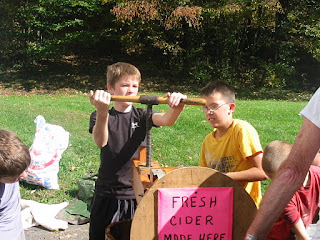We finished the last ham before the next set of pig meat comes home. We had most of the hams cut into ham steaks when we had last year's pigs butchered so each of our hams are pretty small - maybe 2-3 pounds with a big bone in them.
One Ham - Four meals.
Meal number one: Plain old baked ham with the usual sides
(after this I cut off as much meat from the bone as I easily could and cubed it)
Meal number two: Creamy Ham and Potato Soup
Meal number three: VanVoorst Ham Casserole
Meal number four: Basic Ham and Bean Soup
____________________
Here are the recipes!
(My kids said they're all keepers)
Creamy Ham and Potato Soup
3-1/2 c. peeled and diced potatoes
1/3 c. diced celery
1/3 c. finely chopped onion
1/2 c. chopped carrot
1 c. diced cooked ham
3-1/4 c. chicken broth
1/2 tsp. salt or to taste
1 tsp pepper
5 Tbs. butter
5. Tbs. all-purpose flour
2 cups milk
1 c. shredded cheddar cheese
Combine the potatoes, celery, onion, carrot, ham, and chicken broth in a stockpot. Bring to a boil and cook over medium heat until potatoes are tender, about 10-15 minutes.
In a separate saucepan, melt butter over medium low heat. Whisk in flour, and cook, stirring constantly until thick, about 1 minute. Slowly stir in milk so that lumps don't form and until all of the milk has been added. Continue stirring over medium low heat until it starts to thicken, 4 -5 minutes. Add cheese, stirring constantly until melted.
Stir the milk mixture into the stock pot and cook until soup is heated through.
Top with cheddar cheese, chives, and bacon if desired. Serve immediately.
6 Servings
I found and copied this recipe when I was going down the Internet blog rabbit hole and cannot find who wrote it. If you come across this and it's yours, please let me know so that I can credit it to you.
VanVoorst Ham Casserole
10 oz. cooked spiral pasta
2 c. cubed cooked ham
1 c. sour cream
1 (10 oz.) can condensed cream of mushroom soup
1/2 c. shredded mozzarella cheese
1 Tbs. prepared yellow mustard
1 Tbs chopped fresh parsley
salt and pepper to taste
1/2 shredded mozzarella cheese
1 Tbs. chopped fresh parsley
Preheat oven to 350-degrees. Grease a 2 quart casserole dish.
Mix together the ham, sour cream, mushroom soup, 1/2 c. mozzarella cheese, mustard, and 1 Tbs. parsley in a bowl until well combined. Fold in the cooked pasta, season to taste with salt and pepper. Spoon the mixture into the prepared casserole dish and top with 1/2 c. mozzarella cheese and 1 Tbs. parsley.
Bake in preheated oven until hot and bubbly and the topping cheese has melted and started to brown, about 30 minutes. Let stand 5-10 minutes before serving.
I found this recipe online at "www.allrecipes.com". They have a fantastic application where you plug in the ingredients you have and then the site searches for recipes.
Basic Ham and Bean Soup
1 pound dry Great Northern Beans
8 c. water
1/2 tsp. salt
1 ham hock or bone
1 c. chopped carrots
1/2 stalk celery, chopped
1 c. chopped onion
1 tsp. minced garlic
1 tsp. mustard powder
2 bay leaves
2 cups chopped ham
1/2 tsp pepper
Rinse the beans, sorting out broken and discolored ones. In a large pot over high heat, bring the water to a boil. Add the salt and the beans and remove from heat. Let beans sit in the hot water for at least 60 minutes.
After 60 minutes of soaking, return the pot to high heat and place the ham bone, carrots, celery, onion, garlic, mustard and bay leaves in the pot. Stir well, bring to a boil, reduce heat and simmer for 60 more minutes.
Remove ham bone and discard. Stir in the chopped ham an simmer for 30 more minutes. Season with pepper to taste.
- from www.allrecipes.com (Also on allrecipes.com it's fun to look at the comments and see what modifications other people have made to the recipes.)
Here are my modifications to this recipe: I regularly buy big bags of beans and cook them up for about 45 minutes, then drain and freeze them in quart bags (it's much cheaper, tastier, and you don't get the high amount of salt). For this recipe I had a mix of great northern and pinto beans.
I used my ham bone which still had on it the meat I could not easily get off.
I cooked this soup in my crock pot! I started it around noon and put it on high for an hour then on low for about five hours.
When it was done cooking I pulled out the ham bone and picked off the meat. It's a lot easier to get off after it's cooked for awhile. Remove the bay leaves.
____________________
I love cooking soups and casseroles because the recipes are not really set in stone. For example, the Basic Ham and Bean Soup calls for 1 c. chopped onion. I had a half of an onion in my 'fridge and didn't want to run out to get another onion. I went with whatever half an onion gave me. The soup was still yummy.
Also, I'm pretty sure I didn't pull 4 cups of meat off this ham (which is the total amount called for in the three recipes). I just threw in as much as I thought would taste good in the recipe and split it three ways. The Basic Ham and Bean Soup doesn't really need a ham bone and 2 cups of chopped ham. The bone is going to flavor it up nicely and a little bit of added meat goes a long way!
Enjoy!















































